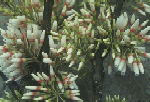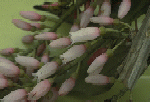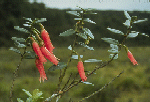- 13. Thibaudia RUIZ & PAVON ex JAUME SAINT-HILAIRE Expos. Fam. 1: 362 (1805).
- -- Lectotype: Thibaudia mellifera
RUIZ & PAVON ex JAUME SAINT-HILAIRE.
- Eurygania KLOTZSCH, Linnaea 24: 15, 26 (1851). -- Type: Eurygania parvifolia
KLOTZSCH.
- Calopteryx A. C. SMITH, J. Arnold Arbor. 27: 100 (1946). -- Type: Calopteryx insignis
A. C. SMITH.
References: SMITH, A. C., Studies of South American plants, XI. Noteworthy species
of Hippocrateaceae and Vacciniaceae. J. Arnold Arbor. 27: 86--120, 4 figs. (1946).



Epiphytic or terrestrial shrubs. Leaves alternate, coriaceous or subcoriaceous, margin
entire or crenulate, pinnate or plinerved, petiolate. Inflorescence axillary or
terminal, pin-cushion type (glomerulate), fasciculate, racemose, or paniculate, rarely ramiflorous, with few to many flowers; pedicel deciduously bibracteolate. Flowers
5-merous, without odor; aestivation valvate; calyx articulate with the pedicel
or rarely continuous; hypanthium short-cylindric or campanulate, terete, occasionally
narrowly 5-angled, or rarely conspicuously winged to the sinuses; limb erect to slightly
spreading distally; lobes triangular, subacute; corolla cylindric to subcylindric,
terete, occasionally 5-angled, rarely weakly to strongly winged, the lobes triangular or oblong, subacute; stamen 10, equal, often nearly as long as the corolla; filaments
equal, distinct or connate, lacking spurs; anthers equal, dorsally attached near
the base, firm or membranous, lacking disintegration tissue; thecae smooth or slightly granular; tubules about as long as the thecae, dehiscing by elongate introrse
clefts; pollen lacking viscin threads; ovary inferior; style filiform, about as
long as the corolla or slightly exserted. Fruit a berry.
Thibaudia
is a genus of about 60 species with one species in Panama and Costa Rica and the
others ranging from Colombia to Bolivia and eastward to Suriname and Guayanan Brazil.
Key to the Species of Thibaudia
- 1a.
- Calyx continuous with pedicel, not articulated.
- 2a.
- Both calyx and corolla strongly, sometimes broadly, and conspicuously winged
- ............................................................................................T. litaënsis
- 2b.
- Calyx and corolla terete, or sometimes angled or narrowly winged, but not conspicuously
winged.
- 3a.
- Inflorescence fasciculate, subtended by a persistent series of narrowly triangular
to linear-lanceolate, striate bracts to 15 x 2 mm
- ...................................................................................T. sessiliflora
- 3b.
- Inflorescence short- or long-racemose, 0.2--9 cm long, subtended by deciduous,
oblong to ovate, membranaceous bracts to 2 x 1 mm.
- 4a.
- Rachis 2--9 cm long; inflorescence 15--30-flowered; leaves 2.5--7.5 cm wide
- ..........................................................................T. floribunda
- 4b.
- Rachis 0.2--1.1 cm long; inflorescence 1--10-flowered; leaves 5.5--14 cm wide.
- 5a.
- Inflorescence 1-flowered; rachis 2--3 mm long; calyx hypanthium winged (narrowly
and inconspicuously) at anthesis; corolla red at base with green apex; Oriente
- .................................................................T. lateriflora
- 5b.
- Inflorescence 2--10-flowered; rachis 4--11 mm long; calyx hypanthium terete
at anthesis; corolla red at base with white apex; Cordillera Occidental
- .................................................................T. inflata
- 1b.
- Calyx articulate with pedicel.
- 6a.
- Filaments distinct.
- 7a.
- Corolla less than 15 mm long; anther thecae about equalling the tubule in length
or shorter.
- 8a.
- Leaves less than 4 x 2 cm, pinnately nerved; pedicel 1--2 mm long; flowers pilose;
calyx 9--14 mm long, the lobes 5--9 mm long
- ...........................................................................T. jorgensenii
- 8b.
- Leaves 7--23 x (3.5-) 4--9 cm, plinerved; pedicel 10--20 mm long; flowers glabrous;
calyx 5--6.5 mm long, the lobes equal to or less than 1 mm long.
- 9a.
- Leaves 7--13 cm long, the margins sinuate-crenate, the base strongly cordate and
subauriculate; pedicel 10 mm long; calyx limb bearing 5 circular glands at base
- .................................................................T. clivalis
- 9b.
- Leaves (8-) 12--23 cm long, the margins entire, the base rounded or obtuse, often
narrowly attenuate; pedicel 17--20 mm long; calyx limb without glands
- ..................................................................T. lugoi
- 7b.
- Corolla greater than 20 mm long; anther thecae usually two or more times longer
than the tubules.
- 10a.
- Leaves pinnately nerved with 4--7 pairs of nerves arising at high angles, ovate,
the base rounded and subcordate, usually clasping the stem; pedicel 4.5--6 cm long
- ...........................................................................T. pachyantha
- 10b.
- Leaves plinerved with 2--3 pairs of nerves arising at low angles and running
the length of the leaf, sometimes the inner 1--2 pairs of nerves arising several
centimeters above the base, elliptic, narrowed at both ends, if the leaves are basally
rounded, then the leaves clearly petiolate and not clasping the stem; pedicel 1.8--4.5
cm long.
- 11a.
- Inflorescence subfasciculate, 2--6-flowered; rachis to 0.6 cm long; calyx ca
14 mm long; corolla 2 times calyx length
- .................................................................T. harlingii
- 11b.
- Inflorescence racemose, 6--15-flowered; rachis 1.5--4 cm long; calyx 6--10
mm long; corolla 3--4 times calyx length.
- 12a.
- Calyx hypanthium 2 mm long, basally apophysate; calyx limb 3--5 times hypanthium
length; corolla 4 times calyx length; calyx 6 mm long; petiole to 5 mm long
- ......................................................T. andrei
- 12b.
- Calyx hypanthium 3--5 mm long, basally rounded or truncate, not apophysate;
calyx limb 1.5--3 times hypanthium length; corolla ca 3 times calyx length; calyx
8--11 mm long; petiole 5--20 mm long
- ......................................................T. martiniana
- 6b.
- Filaments connate.
- 13a.
- Inflorescence paniculate
- ...................................................................................T. albiflora
- 13b.
- Inflorescence racemose, fasciculate, or flowers solitary.
- 14a.
- Leaves > 10 cm long
- ..........................................................................T. gunnari
- 14b.
- Leaves < 4 cm long.
- 15a.
- Flowers (calyx, corolla, and pedicel) densely tomentose to woolly
- .................................................................T. anomola
- 15b.
- Flowers glabrous to short-pilose.
- 16a.
- Leaves obovate to oblong-obovate, 3--6 cm long, the base long-tapering and cuneate,
the apex rounded and retuse
- ........................................................T. retusifolia
- 16b.
- Leaves ovate to oblong, 1.2--3 cm long, the base rounded to subcordate, the apex
acute to rounded, not retuse.
- 17a.
- Leaves flat, soft pilose on both surfaces, apically subacute and callose-apiculate;
bracts subtending inflorescence 8--10 mm long; flowers more or less sessile; corolla
10 mm long
- ...............................................T. steyermarkii
- 17b.
- Leaves often marginally revolute, glabrous, apically obtuse to subacute; bracts
at base of inflorescence < 2 mm long; flowers with pedicel 5--8 mm long; corolla
17--19 mm long, short-pilose to puberulent, lobes to 5 mm long
- ...............................................T. parvifolia


